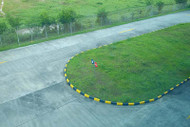A high-traffic retail environment refers to a commercial space that experiences a significant number of customers daily. Such busy retail establishments as shopping malls, departmental stores, supermarkets, or popular designer boutiques are commercially busy. High traffic or high foot traffic poses unique challenges for retailers, requiring them to address issues like durability, safety, efficiency, and aesthetics to ensure a positive shopping experience for customers. Retailers in high-traffic environments are much more careful with factors such as floor materials, store layout, and crowd management to increase their merchandising strategies and services for effective navigation and capitalization opportunities. To withstand the high-traffic environment, retailers look for sustainable solutions.
This article elaborates on two solutions for high-traffic environments in the retail environment.
1: Epoxy Flooring Solution
Epoxy flooring can be an excellent solution for high-traffic retail environments. Many factors promote epoxy flooring as a favourable solution.
A: Durability and longevity: Epoxy flooring is highly durable and can withstand heavy foot traffic. It is the ideal choice for busy retail spaces due to its tough properties and resistant nature. Epoxy solutions can allow heavy shopping carts and the movement of customers without showing signs of damage.
B: Resistance to stains and chemicals: Another factor that favours the epoxy solution in high-traffic environments is its ability to resist strain and chemicals. Epoxy flooring provides a protective barrier against liquids, preventing them from seeping into the floor or causing any damage. This resistance makes epoxy an excellent choice for retail spaces to deal with food, beverages, and other potentially corrosive things.
C: Seamless and Easy to Clean: Epoxy is easy to clean and seamless. Epoxy flooring has no joints or seams where debris can be collected or swept through. It is thus easier to clean and maintain. Regular maintenance and occasional machine scrubbing are what make epoxy floors clean and hygienic, creating a pleasant shopping experience for customers.
D: Aesthetically pleasing and customizable: Epoxy flooring offers a wide range of design options, allowing retailers to customise the design and appearance of the floor to match the brand identity. The retailer can use colours, decorative flakes, metallic finishes, and custom patterns. The visually appealing environment reflects the ambience of the space and thus allows the customer to have a better experience and the retailer a more cost-effective solution.
E: Slip Resistance: Epoxy flooring can be formulated with slip-resistant additives to enhance safety in high-traffic areas. This feature minimizes the risk of slips and falls, ensuring a safer environment for both customers and employees, especially in areas prone to spills or moisture.
F: Low VOC Options: Many epoxy flooring systems now come with low or zero volatile organic compounds (VOCs), making them environmentally friendly and healthier for indoor air quality. This is particularly important in retail spaces where customers spend considerable time.
G: Cost-Effectiveness Over Time: While the initial investment in epoxy flooring may be higher than other options, its longevity and low maintenance requirements make it a cost-effective choice over time. Retailers benefit from reduced replacement costs and fewer disruptions during business hours.
H: Enhanced Lighting Reflection: The glossy finish of epoxy flooring can enhance the overall lighting in retail spaces. This reflective quality can make areas appear brighter and more inviting, contributing to a better shopping experience.
2: Interlocking tile solution
Interlocking tiles and their application is another solution for high-traffic retail environments. The versatility and ease of installation have found their way around the high-traffic environment. Some of the favourable factors that help address the challenging high-traffic environment are as follows:
A: Durability and Strength: Interlocking tiles are typically made from durable materials like PVC, rubber, and polypropylene. These materials are designed to withstand heavy foot traffic, making them a suitable and likeable choice for retail spaces. Interlocking tiles withstand carts, trolleys, and heavy objects.
B: Quick and Easy Installation: Interlocking tiles feature a unique design that allows them to easily connect and lock together without the need for any adhesive or special tool. This makes interlocking tiles more preferred for installation in retail spaces.
C: Customizable Design Options: Interlocking tiles are available in a variety of colours, patterns, and textures, allowing retailers to customise the look to align with brand images and mix them with unique patterns for branding and flexibility. The design creates a visually appealing floor that enhances the overall aesthetic of the space.
D: Flexibility and Portability: Interlocking tiles offer flexibility in terms of installation and portability. They are easy to remove and reinstall if the layout of the retail space is changed or repaired. A retailer can use interlocking tiles to refurbish the space or look of a mall or shop.
E: Sound Absorption: Interlocking tiles can provide sound-dampening qualities, reducing noise levels in busy retail environments. This feature contributes to a more pleasant atmosphere, allowing customers to navigate the space without feeling overwhelmed by noise.
F: Easy Repairs and Replacement: If a section of interlocking tiles becomes damaged, individual tiles can be easily replaced without needing to overhaul the entire floor. This ease of repair saves both time and money, making it an attractive option for retailers.
G: Moisture Resistance: Many interlocking tiles are designed to resist moisture, making them suitable for areas where spills are likely, such as near food and beverage displays. This resistance helps maintain the integrity of the flooring and ensures a clean environment.
Conclusion:
High-traffic environments are mostly hard to close, and they tend to be publicly available as well. Retailers tend to be more cost-effective when redecorating or covering damaged floors. Epoxy and interlocking tiles are the two most cost-effective and beneficial solutions that retailers use. Based on their durability, flexibility, resistance, and low maintenance, these two solutions are highly preferred and utilised.

